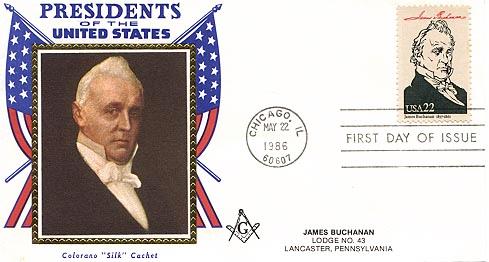James
Buchanan
Fifteenth
President of the United States

James Buchanan, the 15th
PRESIDENT OF THE UNITED STATES (1857-1861), served during the beginning of the
secession crisis that led to the Civil War. Of Scottish-Irish descent, he was
born on Apr. 23, 1791, in Cove Gap, near Mercersburg, Pa., the son of James
Buchanan, a prosperous storekeeper, and his wife, Elizabeth Speer.
Young James received an academy education and attended Dickinson College,
Carlisle, Pa., graduating in 1809. He then studied law in Lancaster, where he
began practice in 1813. Although a FEDERALIST in political sympathies, he
supported the prosecution of the War of 1812 and participated as a volunteer
in the defense of Baltimore.
After serving in the Pennsylvania House of Representatives (1814-16), Buchanan
devoted attention to his law practice, which soon prospered. In 1819 he became
engaged to Ann Coleman, daughter of a wealthy Lancaster iron manufacturer, but
as a result of a misunderstanding the engagement was ended. Her sudden death
shortly thereafter left Buchanan desolate. He never married.
In 1820, Buchanan was elected to the U.S. HOUSE OF REPRESENTATIVES. With the
collapse of the Federalist party, he supported Andrew JACKSON for the
presidency. In the late 1820s he emerged as the leader of the Amalgamation
party, the dominant faction of Pennsylvania Jacksonians.
Buchanan retired from CONGRESS in 1831 but later that year accepted Jackson's
offer of the ministry to Russia. He remained at St. Petersburg from 1832 to
1834, where he concluded a commercial treaty. Shortly after his return he was
elected to the U.S. SENATE, where he served from 1834 to 1845.
Mentioned as a possible
presidential candidate in 1844, Buchanan became (1845) secretary of state in
the cabinet of President James K. POLK. Although Polk personally directed the
formulation of foreign policy, Buchanan worked diligently in matters relating
to the consummation of the annexation (1845) of Texas, the settlement of the
Oregon Question, and the Mexican War. He retired from office at the end of the
Polk administration in 1849. Buchanan was a serious contender for the
DEMOCRATIC nomination in 1852 but lost to Franklin PIERCE, who named him
minister to Great Britain. His mission in London (1853-56) accomplished little
but benefited him politically, for he remained aloof from the controversy over
the Kansas-Nebraska Act (1854).
At the Democratic convention in
1856, Buchanan won the presidential nomination on the 17th ballot. In the fall
he won an ELECTORAL victory, although he failed to get a popular majority over
John C. Fremont, the Republican, and Millard FILLMORE, the KNOW-NOTHING
candidate.
Two days after Buchanan's
inauguration, the Supreme Court declared in the Dred Scott case that Congress
had no power over slavery in the territories. He welcomed this ruling as
the final word on that issue, but the REPUBLICANS and many Northern Democrats
refused to accept the Court's opinion. Like Pierce, Buchanan met difficulties
in organizing Kansas Territory. He urged Congress to accept the territory's
proslavery LeCompton Constitution, even though it had been drawn up by an
unrepresentative convention that had refused to submit it to the people.
Stephen A. Douglas, Democratic senator of Illinois, broke with Buchanan,
arguing that the president's stand made a mockery of the doctrine of Popular
Sovereignty. Ultimately the constitution was referred to the Kansas
electorate, which overwhelmingly rejected it.
With his long experience in
diplomacy, Buchanan expected his administration to conduct a vigorous foreign
policy. He sought to extend American influence in the Caribbean, but
congressional opposition forced him to give up efforts to purchase Cuba from
Spain. Inevitably, domestic matters intruded upon his attention. The panic of
1857 added to the unpopularity of his administration and contributed to heavy
Democratic losses in the congressional elections of 1858.
The sectional controversy grew
steadily more serious during the last two years of Buchanan's presidency. The
raid by John Brown at Harpers Ferry and Brown's execution by Virginia
authorities in 1859 intensified public feeling in both the South and the
North. In the presidential campaign of 1860 the Democratic party split, and
Buchanan endorsed Vice-President John C. BRECKINRIDGE of Kentucky, whom he
considered the regular nominee, instead of Douglas, the candidate of the
Northern Democrats.
The election of Abraham LINCOLN,
the Republican candidate, prompted the secession of seven Southern states and
the creation of the Confederate States of America during Buchanan's last
months in office. The president was criticized by secessionists because he
denied the legality of their action and by Northern advocates of a more
vigorous policy because he believed that the executive lacked the power to
coerce a state. He based his hopes for the survival of the Union on
last-minute compromise efforts, which failed. As the more pro-Southern cabinet
members resigned during the crisis, he took a stronger pro-Union stand,
refusing to turn over Fort Pickens in Florida and Fort Summer in South
Carolina to the authorities in those secessionist states.
During the Civil War Buchanan
generally supported Lincoln's war policies while preparing a defense of his
own administration, which he published in 1866. He died at his estate,
Wheatland, near Lancaster, on June 1, 1868.
Buchanan's reputation is judged
mainly by his conduct during the last months of his presidency, and he is
therefore generally regarded as an ineffective executive. In his defense it
can be said that he was a lame-duck president caught in a vicious crossfire
between secessionists and Republicans. But at the same time his adherence to a
conservative legalism led him to interpret narrowly his powers to deal with an
unprecedented constitutional crisis.

